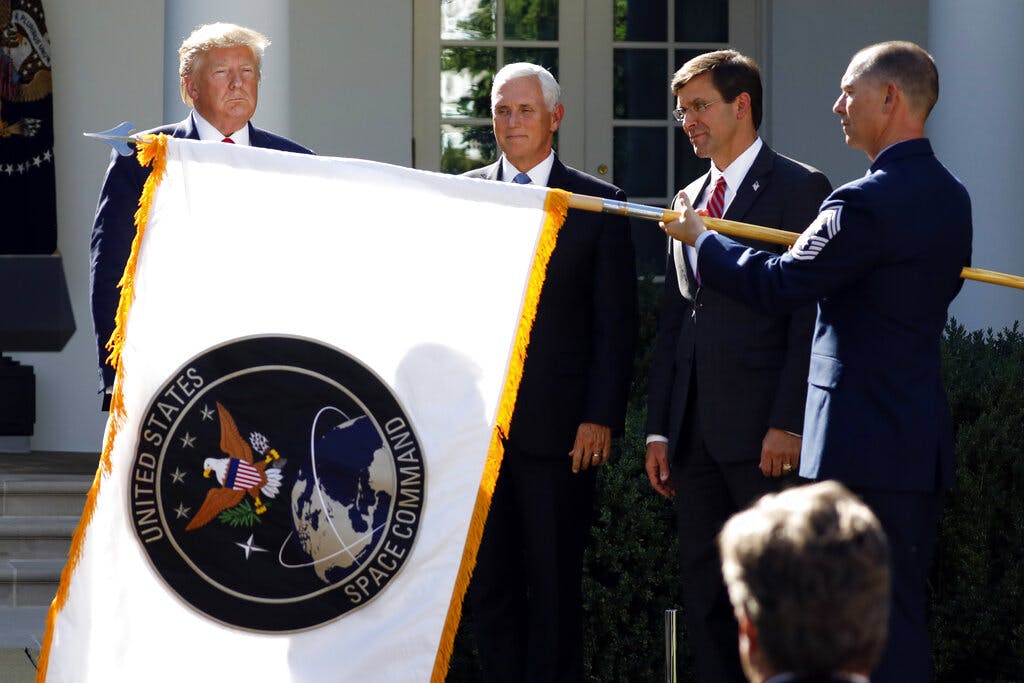Spy Balloon — Who Ya Gonna Call?
America may not be able to pop Beijing’s balloon, and such impotence is what the U.S. Space Force was designed to avoid.

As the latest Communist Chinese spy balloon drifts over America’s heartland, citizens and President Trump are crying, “Shoot it down,” but it’s capable of lurking at 100,000 feet, twice the ceiling of commercial jets. Even if the Pentagon pegging it at 60,000 feet is accurate, that’s close to the limit even of the new F-22 Raptors. Missiles fare little better.
This impotence is what the U.S. Space Force was designed to avoid amid Beijing staking its claim to the moon and its orbit. In 2019, when Mr. Trump forged the new military branch, it was mocked all around and called something out of “Star Trek,” with their similar logos. A sitcom, “Space Force,” was rushed into production so fast, they ended up forgetting the jokes.
Reuters speculated that President Biden would ground the agency in order “to deny Trump a signature achievement,” but when his spokeswoman, Jennifer Psaki, was asked if the administration planned to do so, her dismissive and sarcastic response caused a backlash in Congress, which created the agency with few dissenting votes.
Two Republican congressmen, Michael Rogers of Alabama and Michael Waltz of Florida, said the administration was ignoring the threat from Communist China. In the aftermath, Mr. Biden retreated, but the following summer, Roll Call reported that he was cutting the force’s budget.
Now, Mr. Biden doesn’t have a defense capability up where the satellites roam, so he’s dodging questions. The administration shrugs that the balloon isn’t a danger, and blusters that it could shoot it down but doing so — even over the unpopulated wilds of Montana — might hurt someone.
The truth is, America may not be able to pop Beijing’s balloon. “Taking into account the altitude,” an electronics engineer and colonel in the Hellenic Air Force, Konstantinos Zikidis, told the Sun’s Anthony Grant, “most anti-aircraft or anti-ballistic missiles would not be capable of shooting it down.”
The only arrows in America’s quiver that could “marginally reach and hit such a high-flying balloon,” Mr. Zikidis said, aren’t designed to hit a slow-moving object “exhibiting low doppler effect and small infrared signature,” but Space Force was created to counter such threats in low-earth orbit.
In their 1983 hit “99 Red Balloons,” the West German band Nena stroked the same cynical cords of those who mocked Space Force, casting Americans as paranoid warmongers and singing, “Everyone’s a Captain Kirk,” just as fellow leftists belittled President Reagan’s Strategic Defense Initiative as “Star Wars.”
Nevertheless, Germans expect Americans to defend Europe from Russia — just as, after Hawaiians panicked over the false alert of an incoming ICBM in 2018, that Democratic bastion cried out for a missile defense. It wasn’t there, in large part, because their elected officials opposed funding a Republican president’s idea.
In 1957, the USSR’s Sputnik satellite loomed overhead, warning Americans that ensuring freedom meant joining the space race. Now, the Red Balloon demonstrates the threat posed by another communist hegemony, and cements the Space Force as an essential part of our national defense.

